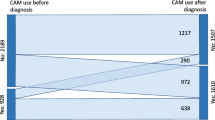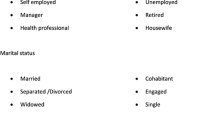Abstract
Goals of work
The use of complementary and alternative medicine (CAM) amongst oncology patients is widespread. There is little data regarding the sources of clinical information on CAM that oncology practitioners utilise. The aim of this study was to investigate the sources of clinical information on CAM utilised by Australian oncology practitioners.
Methods
A structured self-administered questionnaire was sent to Australian oncology practitioners, defined as oncologists, oncology pharmacists and pharmacists at drug information centres (DICs). Key information was sought on their level of satisfaction with the accessibility, reliability and usefulness of this information and the frequency of, and initiating factors for, seeking this information.
Main results
A substantial proportion of oncologists (57.1%) reported having never sought information on CAM, compared to 27.3% of oncology pharmacists, and 18.8% of DIC pharmacists. Oncologists most commonly reported seeking information on CAM one to three times per year compared to four to ten times per year for oncology pharmacists. Databases were the most common information source used by oncologists (48.1%) and oncology pharmacists (91.7%) and the second most common information source used by DICs (92.3%). There was wide variation in the source of clinical information on CAM used by the three different professional groups.
Conclusion
Oncology practitioners often seek information on CAM; however the frequency, nature and sources of information utilised varied widely. The usefulness and reliability of the sources utilised were inconsistent.
Similar content being viewed by others
References
Bennet J, Brown CM (2000) Use of herbal remedies by patients in a health maintenance organisation, J Am Pharm Assoc 40: 353–358
Begbie SD (1996) Patterns of alternative medicine use by cancer patients. Med J Aust 165: 545–548
Boon H, Stewart M, Kennard MA, Gray R, Sawka C, Brown JB, McWilliam C, Gavin A, Baron R, Aaron D, Haines-Kamkal T (2000) Use of complementary/alternative medicine by breast cancer survivors in Ontario: prevalence and perceptions). J Clin Oncol 18: 2515–2521
Boon H, Brown JB, Gavin A, Kennard MA, Stewart M (1999) Breast cancer survivors’ perceptions of complementary/alternative medicine (CAM).: making the decision to use or not to use. Qual Health Res 9: 639–635
Bourgeault IL (1996) Physicians’ attitudes towards patients’ use of alternative therapies. CMAJ 155: 1679–1685
Chavez ML, Chapman RL (1997) In search of literature on alternative therapies. Am J Health Syst Pharm 54: 2635–2638
Crocetti E, Crotti N, Montella M, Musso M (1996) Complementary medicine and oncologists’ attitudes: a survey in Italy. Tumori 82: 539–542
Drew AK, Myers SP (1997) Safety issues in herbal medicine: implications for the health professions. Med J Aust 166: 538–541
Eisenberg DM, Davis RB, Ettner SL, Appel S, Wilkey S, Van Rompay M, Kessler RC (1998) Trends in alternative medicine use in the United States, 1990–1997: results of a follow-up national survey. JAMA 280: 1569–1675
Ernst E, Cassileth BR (1998) The prevalence of complementary/alternate medicine in cancer: a systematic review. Cancer 84: 777–782
Fisher P, Ward A (1994) Complementary medicines in Europe. Br Med J 309: 107–111
Herbert CP, Verhoef MJ, Martin M, O’Beirne M, Doll R (1999) Complementary therapy and cancer: decision making by patients and their physicians setting a research agenda. Patient Educ Couns 38: 87–92
Hersh WR, Hickam DH (1998) How well do physicians use electronic information retrieval systems? A framework for investigation and systematic review. JAMA 280: 1347–1352
Kaegi E (1998) A patient’s guide to choosing unconventional therapies. CMAJ 158: 1161–1165
Khallil MM, Savidge M, Hakkak R, Hine RJ (2001) The patterns of dietary supplement use among breast cancer patients in Arkansas. Proc Am Soc Clin Oncol 20: 1774
Maher EJ, Young T, Feigel I (1994) Complementary therapies used by patients with cancer. Br Med J 309: 671–672
Metz JM, Devine P, DeNittis A, Stambaugh M, Jones H, Goldwein J, Whittington R (2001) Utilisation of the internet by oncology patients to obtain cancer related information. Proc Am Soc Clin Oncol 20: 1575
Munstedt K, Kirsch K, Milch W, Sachsse S, Vahrson H (1996) Unconventional cancer therapy: survey of patients with gynaecological malignancy. Arch Gynecol Obstet 258: 81–88
Newell S, Sanson-Fisher RW (2000) Australian oncologists’ self-reported knowledge and attitudes about non-traditional therapies used by cancer patients. Med J Aust 172: 110–113
O’Malley AS, Kerner JF, Johnson L (1999) Are we getting the message out at all? Health information sources and ethnicity. Am J Prev Med 17: 198–200
Owen DK, Lewith G, Stephens CR (2001) Can doctors respond to patients’ increasing interest in complementary and alternative medicine? Br Med J 322: 154–158
Paltiel O, Avitzour M, Peretz T, Cherny N, Kaduri L, Pfeffer M, Wagner N, Soskolne V (2001) Determinants of the use of complementary therapies by patients with cancer. J Clin Oncol 19; 2439–2448
Richardson MA, White JD (2000) Complementary/alternative medicine and cancer research. A national initiative. Can Pract 8: 45–48
Richardson MA, Sanders T, Palmer JL (2000) Complementary/alternative medicine use in a comprehensive cancer centre and the implications for oncology. J Clin Oncol 18:2505–2514
Risberg T, Kaasa S, Wist E, Melsom H (1997) Why are cancer patients using non-proven complementary therapies? Eur J Cancer 33: 575–580
Sawyer MG (1994) The use of alternative medicine by children with cancer. Med J Aust 160: 320–322
Schofield PE, Juraskova I, Butow PN (2003) How oncologists discuss complementary therapy use with patients: an audio-tape audit. Support Care Cancer. 11:348–355
Smith R. What clinical information do doctors need? (1996) Br Med J 313: 1062–1068
Sweet VB, Gay WE, Leady MA, Stumpf JL (2003) Usefulness of herbal and dietary supplement references. Pharmacother 37: 494–499
Verhoef MJ, Hilsden RJ, O’Beirne M (1999) Complementary therapies and cancer care: an overview. Patient Educ Couns 38: 93–100
Wharton R, Lewith G (1986) Complementary medicine and the general practitioner. Br Med J 292: 1498–1500
Wood AJJ (2002) Herbal remedies. N Eng J Med 347: 2046–2055
Yakren S, Shi W, Thaler H, Agre P, Bach B, Schrag D (2001) Use of the internet and other information resources among adult cancer patients and their companions. Proc Am Soc Clin Oncol 21: 1589
Zollman C, Vickers A (1999) ABC of complementary medicine. Complementary medicine and the patient. Br Med J 319: 1486–1489
Zollman C, Vickers A (1999) ABC of complementary medicine. Complementary medicine and the doctor. Br Med J 319: 1558–1561
Acknowledgements
The authors would like to acknowledge the support and assistance of the Society of Hospital Pharmacists of Australia and the Clinical Oncological Society of Australia, as well as all oncology practitioners who participated.
Author information
Authors and Affiliations
Corresponding author
Rights and permissions
About this article
Cite this article
Dooley, M.J., Lee, D.YL. & Marriott, J.L. Practitioners’ sources of clinical information on complementary and alternative medicine in oncology. Support Care Cancer 12, 114–119 (2004). https://doi.org/10.1007/s00520-003-0570-5
Received:
Accepted:
Published:
Issue Date:
DOI: https://doi.org/10.1007/s00520-003-0570-5




